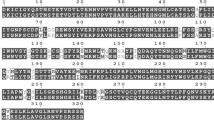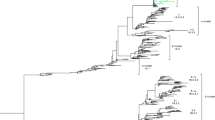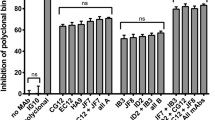Abstract
Genetic and antigenic analysis of H5N1 viruses, isolated in India during a period from year 2006 to 2010, was carried out for selection of the potential H5-HA (haemagglutinin) gene donor virus for developing a reverse genetics based DIVA marker H5 vaccine for poultry in India. Out of the 47 H5N1 viruses (clade 2.2), 14 representative viruses were selected on the basis of amino acid sequence analysis of HA1 gene for further antigenic characterization. Using antigenic cartography, an antigenic map was constructed based on the data of cross-HI (haemagglutinin inhibition) titration of 14 sera versus 14 viruses to visualize the relatedness among the antigens and antigenic coverage of the sera. Sera against five H5N1 viruses (A/crow/Assam/142119/2008, A/chicken/West Bengal/100879/2008, A/chicken/West Bengal/155505/2009, A/chicken/West Bengal/80995/2008 and A/chicken/West Bengal/81760/2008) exhibited maximum (100 %) antigenic coverage, hence, were selected as the potential HA donor viruses. However, the virus strain A/chicken/West Bengal/80995/2008 matched completely with the consensus amino acid sequence of the 47 viruses, therefore, was considered the best HA donor candidate out of the five showing 100 % antigenic coverage. The present study demonstrates a stepwise methodology for logical selection of vaccine strain or HA gene donor strain for developing H5 vaccines using genetic and antigenic data.



Similar content being viewed by others
References
Abbas T, Wilking H, Staubach C, Ziller M, Conraths FJ. Priority areas for surveillance and prevention of avian influenza during the water-bird migration season in Pakistan. Geospat Health. 2011;6(1):107–16.
Bublot M, Le Gros FX, Nieddu D, Pritchard N, Mickle TR, Swayne DE. Efficacy of two H5N9-inactivated vaccines against challenge with a recent H5N1highly pathogenic avian influenza isolate from a chicken in Thailand. Avian Dis. 2007;51:332–7.
Dubey SC, Nagarajan S, Tosh C, Bhatia S, Krishna. Avian influenza: a long-known disease and its current threat. Indian J Anim Sci. 2009;79:113–40.
Fouchier RA, Smith DJ. Use of antigenic cartography in vaccine seed strain selection. Avian Dis. 2010;54:220–3.
Horimoto T, Kawaoka Y. Pandemic threat posed by avian influenza A viruses. Clin Microbiol Rev. 2001;14:129–49.
Jadhao SJ, Lee CW, Sylte M, Suarez DL. Comparative efficacy of North American and antigenically matched reverse genetics derived H5N9 DIVA marker vaccines against highly pathogenic Asian H5N1 avian influenza viruses in chickens. Vaccine. 2009;27:6247–60.
Lamb RA, Krug RM. Orthomyxoviridae: the viruses and their replication. In: Knipe DM, Howley PM, editors. Fields virology. 4th ed. Philadelphia: Lippincott William and Wilkins; 2001. p. 1487–532.
Liao YC, Ko CY, Tsai MH, Lee MS, Hsiung CA. ATIVS: analytical tool for influenza virus surveillance. Nucl Acids Res (Web Server issue) 2009; W643–6.
Murugkar HV, Nagarajan S, Tosh C, Bhatia S, Venkatesh G, Jain R, Kumar S, Khandia R, Pandey M, Behera P, Tripathy S, Kulkarni DD, Dubey SC. H5N1 virus outbreaks in poultry in India. Vet Rec. 2008;162:255.
Naeem K, Siddique N. Use of strategic vaccination for the control of avian influenza in Pakistan. Dev Biol. 2006;124:145–50.
Nagarajan S, Murugkar HV, Tosh C, Behera P, Jain R, Tripathi S, Khandia R, Gupta V, Kulkarni DD, Dubey SC. Avian influenza virus (H5N1) in chickens in India. Vet Rec. 2009;164:128.
Pattnaik B, Pateriya AK, Khandia R, Tosh C, Nagarajan S, Gounalan S, Murugkar HV, Shankar BP, Shrivastava N, Behera P, Bhagat S, Peiris JSM, Pradhan HK. Phylogenetic analysis revealed genetic similarity of the H5N1 avian influenza viruses isolated from HPAI outbreaks in chickens in Maharashtra, India with those isolated from swan in Italy and Iran in 2006. Curr Sci. 2006;91:77–81.
Pedersen JC. Hemagglutination-inhibition test for avian influenza virus subtype identification and the detection and quantitation of serum antibodies to the avian influenza virus. Methods Mol Biol. 2008;436:53–66.
Russell CA, Jones TC, Barr IG, Cox NJ, Garten RJ, Gregory V, Gust ID, Hampson AW, Hay AJ, Hurt AC, de Jong JC, Kelso A, Klimov AI, Kageyama T, Komadina N, Lapedes AS, Lin YP, Mosterin A, Obuchi M, Odagiri T, Osterhaus AD, Rimmelzwaan GF, Shaw MW, Skepner E, Stohr K, Tashiro M, Fouchier RA, Smith DJ. Influenza vaccine strain selection and recent studies on the global migration of seasonal influenza viruses. Vaccine. 2008;26:D31–4.
Saitou N, Nei M. The neighbor-joining method: a new method for reconstructing phylogenetic trees. Mol Biol Evol. 1987;4(4):406–25.
Smith DJ, Lapedes AS, de Jong JC, Bestebroer TM, Rimmelzwaan GF, Osterhaus AD, Fouchier RA. Mapping the antigenic and genetic evolution of influenza virus. Science. 2004;305:371–6.
Swayne DE, Beck JR, Garcia M, Stone HD. Influence of virus strain and antigen mass on efficacy of H5 avian influenza inactivated vaccines. Avian Pathol. 1999;28:245–55.
Swayne DE, Lee CW, Spackman E. Inactivated North American and European H5N2 avian influenza virus vaccines protect chickens from Asian H5N1 high pathogenicity avian influenza virus. Avian Pathol. 2006;35:141–6.
Swayne DE, Garcia M, Beck JR, Kinney N, Suarez DL. Protection against diverse highly pathogenic avian influenza viruses in chickens immunized with a recombinant fowl pox vaccine containing an H5 avian influenza hemagglutinin gene insert. Vaccine. 2000;18:1088–95.
Swayne DE, Pavade G, Hamilton K, Vallat B, Miyagishima K. Assessment of national strategies for control of high-pathogenicity avian influenza and low pathogenicity notifiable avian influenza in poultry, with emphasis on vaccines and vaccination. Rev Sci Tech OffIntEpiz. 2011;30(3):839–70.
Tosh C, Murugkar HV, Nagarajan S, Bhatia S, Pateriya AK, Behera P, Jain R, Kumar S, Khandia R, Vanamayya PR, Dubey SC, Ahlawat SPS. Outbreak of avian influenza virus H5N1 in India. Vet Rec. 2007;161:279.
Tosh C, Nagarajan S, Murugkar HV, Jain R, Behera P, Katare M, Kulkarni DD, Dubey SC. Phylogenetic evidence of multiple introduction of H5N1 virus in Malda district of West Bengal, India in 2008. Vet Microbiol. 2008;148:2–4.
Wu WL, Chen Y, Wang P, Song W, Lau SY, Rayner JM, Smith GJ, Webster RG, Peiris JSM, Lin T, Xia N, Guan Y, Chen H. Antigenic profile of avian H5N1 viruses in Asia from 2002 to 2007. J Virol. 2008;82(4):1798–807.
Yassine HM, Lee CW, Suarez DL, Saif YM. Genetic and antigenic relatedness of H3 subtype influenza A viruses isolated from avian and mammalian species. Vaccine. 2008;26:966–77.
Acknowledgments
We are thankful to the Deputy Director General, Education Division, Indian Council of Agricultural Research for providing the necessary funds under National Fellow project and to the Director, Indian Veterinary Research Institute, Indian Council of Agricultural Research for providing necessary infrastructure and other facilities to undertake the work at HSADL, Bhopal.
Author information
Authors and Affiliations
Corresponding author
Rights and permissions
About this article
Cite this article
Bhatia, S., Kunal, A., Khandia, R. et al. Genetic and antigenic analysis of H5N1 viruses for selection of HA-donor virus for vaccine strains. Indian J. Virol. 24, 357–364 (2013). https://doi.org/10.1007/s13337-013-0151-2
Received:
Accepted:
Published:
Issue Date:
DOI: https://doi.org/10.1007/s13337-013-0151-2




